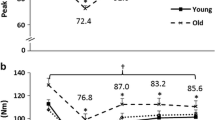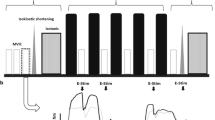Abstract
With adult aging, eccentric strength is maintained better than isometric strength leading to a higher ratio of eccentric/isometric force production (ECC/ISO) in older than younger adults. The purpose was to investigate the ECC/ISO during electrical activation of the adductor pollicis during lengthening (20–320° s−1) contractions in 24 young (n = 12, ∼24 years) and old (n = 12, ∼72 years) males across muscle temperatures (cold ∼19 °C; normal ∼30 °C; warm ∼35 °C). For isometric force, the old were 20–30 % weaker in the normal and cold conditions (P < 0.05) with no difference for the warm condition compared to young (P > 0.05). Half-relaxation time (HRT) did not differ across age for the normal and warm temperatures (P > 0.05), but it slowed significantly for old in the cold condition compared with young (∼15 %; P < 0.05), as well, there was a 20 and 40 % increase in muscle stiffness for the young and old, respectively. ECC/ISO was 50–60 % greater for the cold condition than the normal and warm conditions. There was no age difference in ECC/ISO across ages for the normal and warm conditions (P > 0.05), but for the cold, the old exhibited a 20–35 % higher ECC/ISO than did the young for velocities above 60° s−1 (P < 0.05). A contributing factor to the elevated ECC/ISO is an increased proportion of weakly compared to strongly bound crossbridges. These findings highlight the relationship (r = 0.70) between intrinsic muscle contractile speed (HRT) and eccentric strength in old age.







Similar content being viewed by others
References
Cannon J, Kay D, Tarpenning KM, Marino FE (2006) Normalized lengthening peak torque is associated with temporal twitch characteristics in elderly women but not young women. Acta Physiol (Oxf) 188:53–62. doi:10.1111/j.1748-1716.2006.01606.x
Coupland ME, Puchert E, Ranatunga KW (2001) Temperature dependence of active tension in mammalian (rabbit psoas) muscle fibres: effect of inorganic phosphate. J Physiol 536:879–891
Dalton BH, Allen MD, Power GA, Vandervoort AA, Rice CL (2014) The effect of knee joint angle on plantar flexor power in young and old men. Exp Gerontol 52:70–76. doi:10.1016/j.exger.2014.01.011
Dalton BH, Power GA, Paturel JR, Rice CL (2015) Older men are more fatigable than young when matched for maximal power and knee extension angular velocity is unconstrained. Age (Dordr) 37:9790. doi:10.1007/s11357-015-9790-0
de Ruiter CJ, Jones DA, Sargeant AJ, de Haan A (1999) Temperature effect on the rates of isometric force development and relaxation in the fresh and fatigued human adductor pollicis muscle. Exp Physiol 84:1137–1150
Dipietro L, Caspersen CJ, Ostfeld AM, Nadel ER (1993) A survey for assessing physical activity among older adults. Med Sci Sports Exierc 25:628–642
Ditor DS, Hicks AL (2000) The effect of age and gender on the relative fatigability of the human adductor pollicis muscle. Can J Physiol Pharmacol 78:781–790
Fortuna R, Vaz MA, Herzog W (2012) Catchlike property in human adductor pollicis muscle. J Electromyogr Kinesiol 22:228–233. doi:10.1016/j.jelekin.2011.09.013
Hortobagyi T, Zheng D, Weidner M, Lambert NJ, Westbrook S, Houmard JA (1995) The influence of aging on muscle strength and muscle fiber characteristics with special reference to eccentric strength. J Gerontol A Biol Sci Med Sci 50:B399–B406
Jakobi JM, Rice CL (2002) Voluntary muscle activation varies with age and muscle group. J Appl Physiol 93:457–462
Klass M, Baudry S, Duchateau J (2005) Aging does not affect voluntary activation of the ankle dorsiflexors during isometric, concentric, and eccentric contractions. J Appl Physiol 99:31–38
Lee HD, Herzog W (2002) Force enhancement following muscle stretch of electrically stimulated and voluntarily activated human adductor pollicis. J Physiol 545:321–330
Lee HD, Herzog W (2003) Force depression following muscle shortening of voluntarily activated and electrically stimulated human adductor pollicis. J Physiol 551:993–1003. doi:10.1113/jphysiol.2002.037333
Linari M, Bottinelli R, Pellegrino MA, Reconditi M, Reggiani C, Lombardi V (2004) The mechanism of the force response to stretch in human skinned muscle fibres with different myosin isoforms. J Physiol 554:335–352. doi:10.1113/jphysiol.2003.051748
Linari M, Lucii L, Reconditi M, Casoni ME, Amenitsch H, Bernstorff S, Piazzesi G, Lombardi V (2000) A combined mechanical and X-ray diffraction study of stretch potentiation in single frog muscle fibres. J Physiol 526(Pt 3):589–596
Lowe DA, Surek JT, Thomas DD, Thompson LV (2001) Electron paramagnetic resonance reveals age-related myosin structural changes in rat skeletal muscle fibers. Am J Physiol Cell Physiol 280:C540–C547
Miller MS, Bedrin NG, Callahan DM, Previs MJ, Jennings ME 2nd, Ades PA, Maughan DW, Palmer BM, Toth MJ (2013) Age-related slowing of myosin actin cross-bridge kinetics is sex specific and predicts decrements in whole skeletal muscle performance in humans. J Appl Physiol (1985) 115:1004–1014. doi:10.1152/japplphysiol.00563.2013
Narici MV, Bordini M, Cerretelli P (1991) Effect of aging on human adductor pollicis muscle function. J Appl Physiol (1985) 71:1277–1281
Ochala J, Dorer DJ, Frontera WR, Krivickas LS (2006) Single skeletal muscle fiber behavior after a quick stretch in young and older men: a possible explanation of the relative preservation of eccentric force in old age. Pflugers Arch 452:464–470. doi:10.1007/s00424-006-0065-6
Ochala J, Frontera WR, Dorer DJ, Van Hoecke J, Krivickas LS (2007) Single skeletal muscle fiber elastic and contractile characteristics in young and older men. J Gerontol A Biol Sci Med Sci 62:375–381
Phillips SK, Bruce SA, Newton D, Woledge RC (1992) The weakness of old age is not due to failure of muscle activation. J Gerontol 47:M45–M49
Phillips SK, Bruce SA, Woledge RC (1991) In mice, the muscle weakness due to age is absent during stretching. J Physiol 437:63–70
Piazzesi G, Reconditi M, Koubassova N, Decostre V, Linari M, Lucii L, Lombardi V (2003) Temperature dependence of the force-generating process in single fibres from frog skeletal muscle. J Physiol 549:93–106. doi:10.1113/jphysiol.2002.038703
Porter MM, Vandervoort AA, Kramer JF (1997) Eccentric peak torque of the plantar and dorsiflexors is maintained in older women. J Gerontol A Biol Sci Med Sci 52:B125–B131
Poulin MJ, Vandervoort AA, Paterson DH, Kramer JF, Cunningham DA (1992) Eccentric and concentric torques of knee and elbow extension in young and older men. Can J Sport Sci 17:3–7
Power GA, Allen MD, Booth WJ, Thompson RT, Marsh GD, Rice CL (2014a) The influence on sarcopenia of muscle quality and quantity derived from magnetic resonance imaging and neuromuscular properties. Age (Dordr) 36:9642. doi:10.1007/s11357-014-9642-3
Power GA, Dalton BH, Rice CL (2013a) Human neuromuscular structure and function in old age: A brief review. J Sport Health Sci 2:215–226
Power GA, Makrakos DP, Rice CL, Vandervoort AA (2013b) Enhanced force production in old age is not a far stretch: an investigation of residual force enhancement and muscle architecture. Physiol Rep 1:e00004. doi:10.1002/phy2.4
Power GA, Makrakos DP, Stevens DE, Herzog W, Rice CL, Vandervoort AA (2014b) Shortening-induced torque depression in old men: implications for age-related power loss. Exp Gerontol 57:75–80. doi:10.1016/j.exger.2014.05.004
Power GA, Makrakos DP, Stevens DE, Rice CL, Vandervoort AA (2015) Velocity dependence of eccentric strength in young and old men: the need for speed! Appl Physiol Nutr Metab 40:703–710. doi:10.1139/apnm-2014-0543
Power GA, Rice CL, Vandervoort AA (2012) Increased residual force enhancement in older adults is associated with a maintenance of eccentric strength. PLoS one 7:e48044
Prochniewicz E, Thompson LV, Thomas DD (2007) Age-related decline in actomyosin structure and function. Exp Gerontol 42:931–938. doi:10.1016/j.exger.2007.06.015
Ranatunga KW, Coupland ME (2010) Crossbridge mechanism(s) examined by temperature perturbation studies on muscle. Adv Exp Med Biol 682:247–266. doi:10.1007/978-1-4419-6366-6_14
Roig M, Macintyre DL, Eng JJ, Narici MV, Maganaris CN, Reid WD (2010) Preservation of eccentric strength in older adults: evidence, mechanisms and implications for training and rehabilitation. Exp Gerontol 45:400–409
Roots H, Pinniger GJ, Offer GW, Ranatunga KW (2012) Mechanism of force enhancement during and after lengthening of active muscle: a temperature dependence study. J Muscle Res Cell Motil 33:313–325. doi:10.1007/s10974-012-9307-8
Roots H, Ranatunga KW (2008) An analysis of the temperature dependence of force, during steady shortening at different velocities, in (mammalian) fast muscle fibres. J Muscle Res Cell Motil 29:9–24. doi:10.1007/s10974-008-9138-9
Round JM, Jones DA, Chapman SJ, Edwards RH, Ward PS, Fodden DL (1984) The anatomy and fibre type composition of the human adductor pollicis in relation to its contractile properties. J Neurol Sci 66:263–272
Seiberl W, Power GA, Herzog W, Hahn D (2015). The stretch-shortening cycle (SSC) revisited: residual force enhancement contributes to increased performance during fast SSCs of human m. adductor pollicis. Physiol Rep 3. doi:10.14814/phy2.12401
Vandervoort AA (2002) Aging of the human neuromuscular system. Muscle Nerve 25:17–25
Wang G, Kawai M (2001) Effect of temperature on elementary steps of the cross-bridge cycle in rabbit soleus slow-twitch muscle fibres. J Physiol 531:219–234
Acknowledgments
The authors would like to thank all those who participated in the study. These data were collected at the University of Calgary and was supported by funding from Alberta Innovates-Health Solutions, the Canadian Institutes of Health Research, the Natural Sciences and Engineering Research Council of Canada, The Killam Foundation, and the Canada Research Chair Program. B.H. Dalton is supported by a New Investigator Grant from the Medical Research Foundation, Oregon Health and Science University Foundation. G.A. Power was supported by a Banting postdoctoral fellowship (Canadian Institutes for Health Research; CIHR) and Alberta Innovates Health Solutions.
Author information
Authors and Affiliations
Corresponding author
Ethics declarations
This study was approved by the local ethics committee (REB number 15,396) and the procedures conformed to the Declaration of Helsinki.
Conflict of interest disclosure
The authors declare that they have no conflicts of interest to disclose.
About this article
Cite this article
Power, G.A., Flaaten, N., Dalton, B.H. et al. Age-related maintenance of eccentric strength: a study of temperature dependence. AGE 38, 43 (2016). https://doi.org/10.1007/s11357-016-9905-2
Received:
Accepted:
Published:
DOI: https://doi.org/10.1007/s11357-016-9905-2




